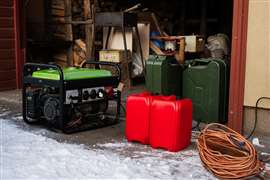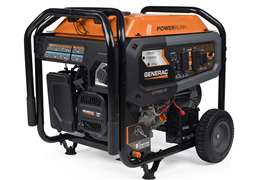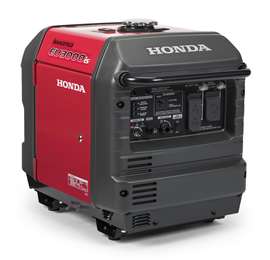Read this article in Français Deutsch Italiano Português Español
Portable gen-set makers concerned about proposed CO rulemaking
18 June 2024
Among the many substances found in small spark-ignited engine emissions is carbon monoxide (CO). Inhaling too much CO can lead to sickness or death.
According to a 2023 report from the U.S. Consumer Products Safety Commission (CPSC), “Fatal Incidents Associated with Non-Fire Carbon Monoxide Poisoning from Engine-Driven Generators and Other Engine-Driven Tools 2012-2022,” 86 percent of the 872 CO poisoning fatalities during that decade were attributed specifically to CO emissions from portable generators.
In April 2023, CPSC announced a modified proposed safety standard for portable generators. Called a supplemental notice of proposed rulemaking (SNPR), CPSC said in the document that the revised proposed rule was intended to address acute CO poisoning from portable generators. Specifically, the proposed rule “limits CO emissions from portable generators and requires generators to shut off when specific emissions levels are reached.”
In April 2024, the trade association Portable Generator Manufacturers’ Association (PGMA) issued a press release urging construction professionals to oppose the proposed rule, saying it would “effectively ban current portable generators” if enacted.
Industry Concerns
 Photo: AS Photo Family via Adobe Stock
Photo: AS Photo Family via Adobe Stock
Susan Orenga, executive director of PGMA, said the proposed rule would require a complete redesign of portable generators.
“It could be a fuel injection system,” she said. “There are other ways, probably, of doing it, but to lower the emissions on these types of generators and on those engines — it would be a full redesign, resourcing of parts.”
According to language in the proposed rule, it would apply to any generators manufactured 180 days after the final rule is published in the Federal Register.
“That’s where the concern comes in from PGMA — that there’s no way this all can be done in 180 days,” Orenga said. “It’s just not feasible.”
Another concern PGMA has with the rule is regarding an increase in portable generator exhaust temperature.
“Industry testing also concludes that the CPSC changes would force portable generators’ exhaust temperatures over 1000°F (538°C),” PGMA said in its press release. “Such extreme temperatures could prompt house fires, lead to burns and threaten users’ safety.”
Orenga said testing revealed current exhaust temperatures vary from under 500°F (260°C) to as much as 600°F (316°C).
An Existing Standard
In its press release, PGMA said CPSC is ignoring a voluntary industry-wide standard, ANSI/PGMA G300-2018, which already includes built-in CO detection and automatic shutoffs.
“When the CO levels get above a certain level, the system automatically shuts off,” Orenga said. “It provides a notification to let users know why it is shutting off so that they can take the generator outdoors if they’re misusing it. Then it won’t restart until the emissions have lowered.”
Orenga said PGMA announced a 2023 version of the standard in December in which the CO emissions threshold was further reduced.
“All of our members, the manufacturers, adhere to that standard,” Orenga said. “100 percent of PGMA-member generators that are being manufactured adhere to the standard. And we have done a significant amount of testing that shows that it’s 98.3 percent effective in mitigating the potential hazards from misuse of bringing your generator inside.”
Orenga added that PGMA estimated that by the end of 2023, 80 – 85 percent of all portable generators on the market complied with the standard.
According to Orenga, the voluntary standard precludes any mandated rule from CPSC.
“CPSC — their statutory authority is they cannot mandate a mandatory standard if there is a voluntary standard that effectively addresses the hazard and is complied by industry,” she said.
A spokesperson for CPSC said via email that under the Consumer Product Safety Act (CPSA), CPSC must rely on voluntary standards instead of mandating standards in certain cases. However, this is only if “compliance with such voluntary standards would eliminate or adequately reduce the risk of injury addressed and it is likely that there will be substantial compliance with such voluntary standards,” they said, adding that CPSA requires CPSC to assess if this is the case.
According to the CPSC spokesperson, the commission’s analyses have led it to find the ANSI/PGMA G300-2018 standard to be less effective than the ANSI/UL 2201 Standard for Carbon Monoxide (CO) Emission Rate of Portable Generators. Additionally, the PGMA standard only addresses shutdown requirements, not CO emissions levels, and the shutdown requirements are less stringent than what CPSC is proposing, the spokesperson said.
CPSC is reviewing comments on the proposed rule, the spokesperson said, and could finalize a rule that doesn’t use the PGMA standard if it determines that the more stringent requirements of the proposed rule are necessary.
Regulatory Disconnect
According to Orenga, a disconnect exists between the U.S. Environmental Protection Agency (EPA) and CPSC in terms of jurisdiction regarding emissions.
“EPA and their requirements for changing anything that has to do with the emissions — it’s a completely different process than what the CPSC is proposing,” Orenga said. “The CPSC has not spoken to the EPA at all, even though we’ve requested many times that they kind of work together on this.”
Orenga added that unlike EPA, CPSC doesn’t have the necessary processes in place to certify emissions.
“So, we’re not even sure how a manufacturer would note that they are adhering to the CPSC rule,” Orenga said.
An EPA spokesperson said that while CPSC and EPA are both agencies of the U.S. government, they each have their own specific areas of responsibility. EPA’s authority derives from the Clean Air Act, and as such is focused on national ambient air quality and emissions standards. In that regard, there is no jurisdictional overlap between CPSC and EPA, the spokesperson said, as CPSC focuses on consumer safety.
They added that EPA does work with CPSC, and EPA has had dialogue with CPSC. However, EPA does not dictate the development of CPSC regulations.
A spokesperson for CPSC said via email that the commission’s mission is to reduce the risk of injury and deaths from consumer products.
“The proposed rule would set performance standards for portable generators to make them safer – it would not ban them,” the spokesperson said. “Consumer product safety standards issued under the Consumer Product Safety Act only apply to products manufactured after the effective date of a final rule, therefore the proposed rule would not and cannot apply to any ‘current portable generators on store shelves.’”
CPSC added that its staff is preparing a notice of availability package to seek additional comments on the proposed rule before it votes on a final rule.
POWER SOURCING GUIDE
The trusted reference and buyer’s guide for 83 years
The original “desktop search engine,” guiding nearly 10,000 users in more than 90 countries it is the primary reference for specifications and details on all the components that go into engine systems.
Visit Now
STAY CONNECTED




Receive the information you need when you need it through our world-leading magazines, newsletters and daily briefings.
CONNECT WITH THE TEAM















